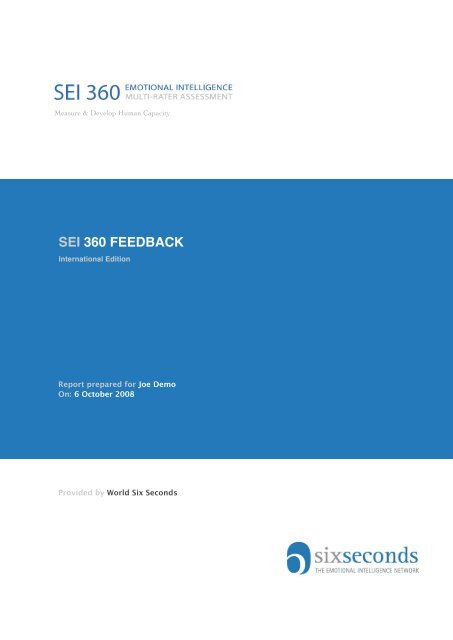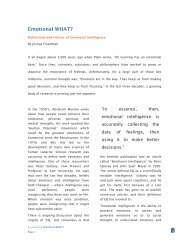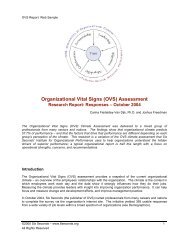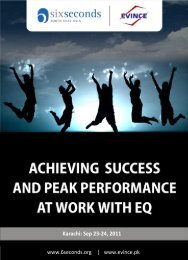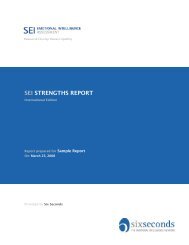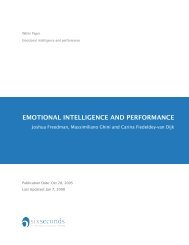SEI 360 FEEDBACK - Six Seconds
SEI 360 FEEDBACK - Six Seconds
SEI 360 FEEDBACK - Six Seconds
You also want an ePaper? Increase the reach of your titles
YUMPU automatically turns print PDFs into web optimized ePapers that Google loves.
Measure & Develop Human Capacity<br />
v<br />
<strong>SEI</strong> <strong>360</strong> <strong>FEEDBACK</strong><br />
International Edition<br />
Report prepared for Joe Demo<br />
On: 6 October 2008<br />
Provided by World <strong>Six</strong> <strong>Seconds</strong>
!<br />
Executive Summary<br />
This report will describe your results on the <strong>SEI</strong> <strong>360</strong>° assessment and illustrate how you and others<br />
perceive your emotional intelligence performance (EP) — EP shows how you are using your emotional<br />
intelligence skills to create optimal relationships.<br />
The report includes:<br />
• Introduction to emotional intelligence and to the <strong>Six</strong> <strong>Seconds</strong> EQ Model.<br />
• Chart of your <strong>SEI</strong> <strong>360</strong>° scores (self evaluation).<br />
• Chart of your <strong>SEI</strong> <strong>360</strong>° scores (others’ evaluation).<br />
• Concluding remarks.<br />
Your Profile at a Glance<br />
This graph shows your and others’ perceptions of your emotional performance. The orange line shows<br />
your self-perception scores; the green shows others’ perceptions. A line closer to the outside of the<br />
graph represents a higher score.<br />
PAGE 2<br />
<strong>SEI</strong> <strong>360</strong> REPORT<br />
!
!<br />
CONTENTS<br />
Section 1: Using this Tool . . . . . . . . . . . . . . . . . . . . . . . . . . . . . . . . . . . . . . 4<br />
Interpreting the Graphs . . . . . . . . . . . . . . . . . . . . . . . . . . . . . . . . . . . 4<br />
Section 2: EQ in Action . . . . . . . . . . . . . . . . . . . . . . . . . . . . . . . . . . . . . . . . 5<br />
Know Yourself . . . . . . . . . . . . . . . . . . . . . . . . . . . . . . . . . . . . . . . . 5<br />
Choose Yourself . . . . . . . . . . . . . . . . . . . . . . . . . . . . . . . . . . . . . . . 5<br />
Give Yourself . . . . . . . . . . . . . . . . . . . . . . . . . . . . . . . . . . . . . . . . 5<br />
Emotional Performance Scores . . . . . . . . . . . . . . . . . . . . . . . . . . . . . . . . 6<br />
Section 3: Core Competencies . . . . . . . . . . . . . . . . . . . . . . . . . . . . . . . . . . . . 7<br />
Section 4: Competencies in Detail . . . . . . . . . . . . . . . . . . . . . . . . . . . . . . . . . . 9<br />
1. Enhance Emotional Literacy . . . . . . . . . . . . . . . . . . . . . . . . . . . . . . . . 10<br />
2. Recognise Patterns . . . . . . . . . . . . . . . . . . . . . . . . . . . . . . . . . . . . 11<br />
3. Apply Consequential Thinking . . . . . . . . . . . . . . . . . . . . . . . . . . . . . . 12<br />
4. Navigate Emotions . . . . . . . . . . . . . . . . . . . . . . . . . . . . . . . . . . . . 13<br />
5. Engage Intrinsic Motivation . . . . . . . . . . . . . . . . . . . . . . . . . . . . . . . . 14<br />
6. Exercise Optimism . . . . . . . . . . . . . . . . . . . . . . . . . . . . . . . . . . . . 15<br />
7. Increase Empathy . . . . . . . . . . . . . . . . . . . . . . . . . . . . . . . . . . . . . 16<br />
8. Pursue Noble Goals . . . . . . . . . . . . . . . . . . . . . . . . . . . . . . . . . . . . 17<br />
Section 5: Outcomes . . . . . . . . . . . . . . . . . . . . . . . . . . . . . . . . . . . . . . . . . 18<br />
Section 6: Numerical Tables . . . . . . . . . . . . . . . . . . . . . . . . . . . . . . . . . . . . . 20<br />
Self-Others . . . . . . . . . . . . . . . . . . . . . . . . . . . . . . . . . . . . . . . . . 20<br />
Largest Gaps . . . . . . . . . . . . . . . . . . . . . . . . . . . . . . . . . . . . . . . . 21<br />
Responses by Question . . . . . . . . . . . . . . . . . . . . . . . . . . . . . . . . . . . 23<br />
Section 7: Narrative . . . . . . . . . . . . . . . . . . . . . . . . . . . . . . . . . . . . . . . . . 25<br />
Examples . . . . . . . . . . . . . . . . . . . . . . . . . . . . . . . . . . . . . . . . . . 25<br />
Start, Stop, Continue . . . . . . . . . . . . . . . . . . . . . . . . . . . . . . . . . . . . 26<br />
Section 8: Conclusions . . . . . . . . . . . . . . . . . . . . . . . . . . . . . . . . . . . . . . . . 27<br />
Reflection . . . . . . . . . . . . . . . . . . . . . . . . . . . . . . . . . . . . . . . . . . 27<br />
Conclusion . . . . . . . . . . . . . . . . . . . . . . . . . . . . . . . . . . . . . . . . . 29<br />
PAGE 3<br />
<strong>SEI</strong> <strong>360</strong> REPORT<br />
!
!<br />
Section 1: Using this Tool<br />
Emotional intelligence is the capacity to integrate reason and emotion to make effective decisions. Emotional<br />
intelligence, sometimes abbreviated “EQ” for “emotional quotient,” describes an internal capacity<br />
rather than a set of behaviors. Just as someone who is strong in mathematical intelligence may or may<br />
not do math problems, someone strong in EQ may or may not use the skills. Emotional Performance<br />
(EP) is a way of describing the behaviors. Someone with strong EP is utilizing their emotional intelligence<br />
and putting it into practice.<br />
The <strong>SEI</strong> <strong>360</strong>° provides feedback about your Emotional Performance from two points of view: your selfevaluation<br />
and others’ evaluations. This report will show you how you see yourself using your EQ skills,<br />
and how others perceive you.<br />
The items on the <strong>SEI</strong> <strong>360</strong>° asked you to reflect on your own behaviors. The tool also asked your<br />
colleagues for their perceptions. The goal is to help you see how you are demonstrating your skills<br />
to others – how you are “coming across.”<br />
Your ability to use EQ is revealed in what you say and do on a daily basis. People who interact with<br />
you regularly are an excellent source of information on your behavior. If you rely solely on one person<br />
who knows you well for feedback, it tends to be biased. When a group of people are asked what they<br />
observe you say and do, trends emerge that reveal evidence of your true Emotional Performance.<br />
Interpreting the Graphs<br />
This is an example of a chart of one competence:<br />
Self (3.5)<br />
All others (4.3)<br />
1 2 3 4 5<br />
The first bar represents your view; the second bar shows the opinion of others who rated you. On the<br />
“Others” bar you’ll see a diamond – this is a performance target calculated from the <strong>SEI</strong> database. If the<br />
target is white, it may be a development area; if it is green, this may be a strength you can leverage.<br />
PAGE 4<br />
<strong>SEI</strong> <strong>360</strong> REPORT<br />
!
!<br />
Section 2: EQ in Action<br />
The <strong>SEI</strong> <strong>360</strong>° is based on the <strong>Six</strong> <strong>Seconds</strong> Emotional Intelligence Model. This model of EQ-in-Action<br />
begins with three important pursuits: to become more aware (noticing what you do), more intentional<br />
(doing what you mean), and more purposeful (doing it for a reason).<br />
Know Yourself<br />
Clearly seeing what you feel and do.<br />
Emotions are data, and these competencies allow<br />
you to accurately collect that information.<br />
Choose Yourself<br />
Doing what you mean to do.<br />
Instead of reacting “on autopilot,” these competencies<br />
allow you to proactively respond.<br />
Give Yourself<br />
Doing it for a reason.<br />
These competencies help you put your vision<br />
and mission into action so you lead with purpose<br />
and full integrity.<br />
Know Yourself gives you the “what” – when you !<br />
Know Yourself, you know your strengths and challenges, you know what you are doing, what you want,<br />
and what to change.<br />
Choose Yourself provides the “how” – it shows you how to take action, how to influence yourself and<br />
others, how to “operationalize” these concepts.<br />
Give Yourself delivers the “why” – when you Give Yourself you are clear and full of energy so that you<br />
stay focused and know why to respond a certain way, why to move in a new direction, and why others<br />
should come on board.<br />
!<br />
PAGE 5<br />
<strong>SEI</strong> <strong>360</strong> REPORT<br />
!
!<br />
Emotional Performance Scores<br />
Your EP scores are shown below — an overall score plus scores in each of the three areas:<br />
Overall Emotional<br />
Performance<br />
Self (4)<br />
All others (3.7)<br />
1 2 3 4 5<br />
Know Yourself<br />
Self (3.3)<br />
All others (3.4)<br />
1 2 3 4 5<br />
Choose Yourself<br />
Self (4.2)<br />
All others (4)<br />
1 2 3 4 5<br />
Give Yourself<br />
Self (4.4)<br />
All others (3.6)<br />
1 2 3 4 5<br />
PAGE 6<br />
<strong>SEI</strong> <strong>360</strong> REPORT<br />
!
!<br />
Section 3: Core Competencies<br />
Within each of the three pursuits, the<br />
<strong>SEI</strong> measures specific competencies<br />
that facilitate each pursuit.<br />
The eight competencies are shown<br />
to the right and in the table below.<br />
On the next page you will see your<br />
scores for each competency.<br />
!<br />
The <strong>Six</strong> <strong>Seconds</strong> EQ Model:<br />
Pursuit Competency Definition<br />
Know Yourself<br />
Choose<br />
Yourself<br />
Your-<br />
Give<br />
self<br />
Taking a proactive perspective of hope and possibility.<br />
Enhance Emotional Literacy<br />
Recognize Patterns<br />
Apply Consequential Thinking<br />
Navigate Emotions<br />
Engage Intrinsic Motivation<br />
Exercise Optimism<br />
Increase Empathy<br />
Pursue Noble Goals<br />
Accurately identifying and interpreting both simple<br />
and compound feelings.<br />
Acknowledging frequently recurring reactions and<br />
behaviors.<br />
Evaluating the costs and benefits of your choices<br />
Assessing, harnessing, and transforming emotions<br />
as a strategic resource.<br />
Gaining energy from personal values & commitments<br />
vs. being driven by external forces.<br />
Recognizing and appropriately responding to others’<br />
emotions.<br />
Connecting your daily choices with your overarching<br />
sense of purpose.<br />
PAGE 7<br />
<strong>SEI</strong> <strong>360</strong> REPORT<br />
!
!<br />
Emotional Performance Scores: Core Competencies<br />
Enhance Emotional<br />
Literacy<br />
Self (3)<br />
All others (3.3)<br />
1 2 3 4 5<br />
Recognise Patterns<br />
Self (3.5)<br />
All others (3.6)<br />
1 2 3 4 5<br />
Apply Consequential<br />
Thinking<br />
Self (4.8)<br />
All others (3.5)<br />
1 2 3 4 5<br />
Navigate Emotions<br />
Self (3.3)<br />
All others (3.8)<br />
1 2 3 4 5<br />
Engage Intrinsic<br />
Motivation<br />
Exercise Optimism<br />
Self (4.5)<br />
All others (4.4)<br />
Self (4.3)<br />
All others (4.1)<br />
1 2 3 4 5<br />
1 2 3 4 5<br />
Increase Empathy<br />
Self (4.5)<br />
All others (3.6)<br />
1 2 3 4 5<br />
Pursue Noble Goals<br />
Self (4.3)<br />
All others (3.7)<br />
1 2 3 4 5<br />
PAGE 8<br />
<strong>SEI</strong> <strong>360</strong> REPORT<br />
!
!<br />
Section 4: Competencies in Detail<br />
In this section you will see a definition of each competency plus your scores. The people who provide<br />
feedback are called “raters” and, depending how your project was created, you could have many different<br />
groups of raters.<br />
In the following charts you will see responses from different groups of raters. “All others” is a compilation<br />
of all the people who provided feedback, excluding your own feedback. “All others” may be<br />
further broken down into subgroups. However, this will only be done when it will not compromise the<br />
anonymity of any of your raters, thus not all categories of raters will necessarily be shown separately.<br />
Your Rater Groups:<br />
Category<br />
Number of<br />
raters<br />
Subordinates 3<br />
Colleagues 3<br />
Supervisors 2<br />
PAGE 9<br />
<strong>SEI</strong> <strong>360</strong> REPORT<br />
!
!<br />
1. Enhance Emotional Literacy<br />
Definition:<br />
compound feelings.<br />
Accurately identifying and interpreting both simple and<br />
Importance: Emotions are chemicals, a form of neurotransmitters, that<br />
provide data about yourself and others; emotions are a feedback system<br />
delivering information that drives behavior and decisions. Emotional<br />
literacy is the capacity to access and interpret that data.<br />
!<br />
!<br />
Emotional literacy helps you notice, name, and understand feelings. This critical information about you<br />
(and about others), gives you insight into the core drivers of behavior. Such understanding is also key<br />
to managing your reactions.<br />
Ratings:<br />
Self (3)<br />
All others (3.3)<br />
Colleagues (3.7)<br />
Subordinates (3)<br />
1 2 3 4 5<br />
PAGE 10<br />
<strong>SEI</strong> <strong>360</strong> REPORT<br />
!
!<br />
2. Recognise Patterns<br />
Definition: Acknowledging frequently recurring reactions and behaviors.<br />
Importance:<br />
Sometimes people assess new situations and respond<br />
carefully and thoughtfully, but frequently they run on autopilot,<br />
reacting unconsciously, based on habit. In part it’s because the human<br />
brain is wired to form and follow neural pathways. Left unconscious,<br />
!<br />
!<br />
these patterns can inhibit optimal performance because they are a generalized response rather than<br />
one carefully tailored to the current situation.<br />
Recognizing Patterns helps you track and monitor your reactions – which is an essential step to managing<br />
them.<br />
Recognizing your own patterns will also help you see others’ patterns – which will be<br />
invaluable in coaching others off of autopilot as well.<br />
Ratings:<br />
Self (3.5)<br />
All others (3.6)<br />
Colleagues (3.9)<br />
Subordinates (3.5)<br />
1 2 3 4 5<br />
PAGE 11<br />
<strong>SEI</strong> <strong>360</strong> REPORT<br />
!
!<br />
3. Apply Consequential Thinking<br />
Definition: Evaluating the costs and benefits of your choices.<br />
Importance: This skill helps you assess your decisions and their effects.<br />
It is key to managing your impulses and acting intentionally (rather than<br />
reacting). It’s a process of analyzing and reflecting, using both thoughts<br />
and feelings, to identify a response that is optimal for yourself and others.<br />
!<br />
!<br />
This competence is critical for making a strategic plan that accounts for the human dynamics – and for<br />
managing your own behavior as you execute that plan.<br />
Ratings:<br />
Self (4.8)<br />
All others (3.5)<br />
Colleagues (3.9)<br />
Subordinates (3.6)<br />
1 2 3 4 5<br />
PAGE 12<br />
<strong>SEI</strong> <strong>360</strong> REPORT<br />
!
!<br />
4. Navigate Emotions<br />
Definition:<br />
strategic resource.<br />
Assessing, harnessing, and transforming emotions as a<br />
Importance: People are often told to control their emotions, to suppress<br />
feelings like anger, joy, or fear, and eliminate them from the decisionmaking<br />
process. However, feelings provide insight and energy; they<br />
drive decision-making and behavior – without emotion people literally<br />
cannot make decisions.<br />
!<br />
!<br />
So rather than ignoring feelings or controlling them through sheer force of will, this competence lets<br />
you manage emotions, gain valuable insight from them, and then transform them so you create feelings<br />
that are helpful to you and others.<br />
Ratings:<br />
Self (3.3)<br />
All others (3.8)<br />
Colleagues (4.2)<br />
Subordinates (4)<br />
1 2 3 4 5<br />
PAGE 13<br />
<strong>SEI</strong> <strong>360</strong> REPORT<br />
!
!<br />
5. Engage Intrinsic Motivation<br />
Definition: Gaining energy from personal values and commitments vs.<br />
being driven by external forces.<br />
Importance: People who require external reinforcement to be motivated<br />
are always at the mercy of others’ approval or reward system. This<br />
ultimately reduces self-efficacy.<br />
!<br />
Engaging Intrinsic Motivation helps you develop and use lasting inner<br />
drivers. This allows you to stand up, challenge the status quo, take risks, and persevere when the going<br />
is tough — and it helps you inspire that in others.<br />
!<br />
Ratings:<br />
Self (4.5)<br />
All others (4.4)<br />
Colleagues (4.2)<br />
Subordinates (4.5)<br />
1 2 3 4 5<br />
PAGE 14<br />
<strong>SEI</strong> <strong>360</strong> REPORT<br />
!
!<br />
6. Exercise Optimism<br />
Definition: Taking a proactive perspective of hope and possibility.<br />
Importance: This learned way of thinking + feeling gives you ownership<br />
of your decisions and outcomes. Everyone uses both optimistic and<br />
pessimistic styles of feeling + thinking, some tend to use one more<br />
often.<br />
!<br />
An optimistic outlook increases the pool of choices and the opportunity<br />
for success. This provides a solution-oriented approach, helps you innovate, and allows you to engage<br />
others’ positive energy. Optimism helps you see beyond the present and take ownership of the future.<br />
!<br />
Ratings:<br />
Self (4.3)<br />
All others (4.1)<br />
Colleagues (4.2)<br />
Subordinates (4.2)<br />
1 2 3 4 5<br />
PAGE 15<br />
<strong>SEI</strong> <strong>360</strong> REPORT<br />
!
!<br />
7. Increase Empathy<br />
Definition: Recognizing and appropriately responding to others’ emotions<br />
Importance: Empathy is a nonjudgmental openness to others’ feelings<br />
and experiences that builds connection and awareness. It starts by<br />
noticing both the pleasant and unpleasant feelings and genuinely caring<br />
what the other person is experiencing. The next steps include listening,<br />
sharing, and responding in a way that shows your concern.<br />
!<br />
!<br />
Empathy is key to understanding others and forming enduring and trusting relationships. It ensures<br />
you take other people into account in your decision-making and gives them a rock-solid assurance that<br />
you are on the same team.<br />
Ratings:<br />
Self (4.5)<br />
All others (3.6)<br />
Colleagues (3.7)<br />
Subordinates (3.2)<br />
1 2 3 4 5<br />
PAGE 16<br />
<strong>SEI</strong> <strong>360</strong> REPORT<br />
!
!<br />
8. Pursue Noble Goals<br />
Definition: Connecting your daily choices with your overarching sense<br />
of purpose.<br />
Importance: Noble Goals activate all of the other competencies in the<br />
<strong>Six</strong> <strong>Seconds</strong> Model. When people examine their personal vision, mission,<br />
and legacy, and use that conviction to set their goals and objectives,<br />
emotional intelligence gains relevance and power.<br />
!<br />
!<br />
When you are clear about your Noble Goal, you feel compelled to pay fierce attention to your daily<br />
choices to ensure that you are not undermining your life’s purpose. Pursuing a Noble Goal facilitates<br />
integrity and ethical behavior, which helps you maintain focus, inspire others, and access your full power<br />
and potential.<br />
Ratings:<br />
Self (4.3)<br />
All others (3.7)<br />
Colleagues (4)<br />
Subordinates (3.1)<br />
1 2 3 4 5<br />
PAGE 17<br />
<strong>SEI</strong> <strong>360</strong> REPORT<br />
!
!<br />
Section 5: Outcomes<br />
The following table shows the ratings you received on various emotional intelligence outcomes.<br />
Self (3)<br />
is in good health<br />
All others (4.5)<br />
Colleagues (4.3)<br />
Subordinates (5)<br />
1 2 3 4 5<br />
Self (3)<br />
seems to have a good<br />
life<br />
All others (4)<br />
Colleagues (4)<br />
Subordinates (4)<br />
1 2 3 4 5<br />
Self (5)<br />
has excellent<br />
relationships<br />
All others (4.2)<br />
Colleagues (4.3)<br />
Subordinates (4.5)<br />
1 2 3 4 5<br />
Self (3)<br />
is achieving her/his<br />
goals<br />
All others (4.2)<br />
Colleagues (4.5)<br />
Subordinates (4)<br />
1 2 3 4 5<br />
Self (4)<br />
makes decisions that<br />
lead to positive results<br />
All others (4.1)<br />
Colleagues (4)<br />
Subordinates (4.5)<br />
1 2 3 4 5<br />
PAGE 18<br />
<strong>SEI</strong> <strong>360</strong> REPORT<br />
!
!<br />
Self (4)<br />
is able to influence<br />
others effectively<br />
All others (3.5)<br />
Colleagues (3.7)<br />
Subordinates (3.5)<br />
1 2 3 4 5<br />
PAGE 19<br />
<strong>SEI</strong> <strong>360</strong> REPORT<br />
!
!<br />
Section 6: Numerical Tables<br />
Self-Others<br />
This table shows your and others’ scores for each part of the EQ Model; this is the same data you saw<br />
above consolidated into one table.<br />
Question text EP KY EEL RP CY ACT NE EIM EO GY IE PNG<br />
Self 4 3.25 3 3.5 4.19 4.75 3.25 4.5 4.25 4.38 4.5 4.25<br />
All others 3.75 3.42 3.29 3.58 3.97 3.52 3.83 4.36 4.11 3.62 3.57 3.68<br />
Colleagues 3.97 3.78 3.67 3.91 4.11 3.91 4.18 4.2 4.17 3.86 3.73 4<br />
Subordinates 3.67 3.25 3 3.5 4.08 3.56 4 4.5 4.22 3.18 3.22 3.13<br />
EP:<br />
KY:<br />
EEL:<br />
RP:<br />
CY:<br />
ACT:<br />
NE:<br />
EIM:<br />
EO:<br />
GY:<br />
IE:<br />
PNG:<br />
Emotional Performance<br />
Know Yourself<br />
Enhance Emotional Literacy<br />
Recognise Patterns<br />
Choose Yourself<br />
Apply Consequential Thinking<br />
Navigate Emotions<br />
Engage Intrinsic Motivation<br />
Exercise Optimism<br />
Give Yourself<br />
Increase Empathy<br />
Pursue Noble Goals<br />
PAGE 20<br />
<strong>SEI</strong> <strong>360</strong> REPORT<br />
!
!<br />
Largest Gaps<br />
Below are the items with the highest gap between your perception (self evaluation) and others’ rating.<br />
For each there is a space for you to reflect about that gap.<br />
Self Rating Higher<br />
Item Self All others<br />
includes others’ feelings when making decisions 5 2.8<br />
What can you learn from this<br />
genuinely cares about people 5 3.43<br />
What can you learn from this<br />
considers the consequences of his/her behavior on others 5 3.57<br />
What can you learn from this<br />
has integrity 5 3.6<br />
What can you learn from this<br />
PAGE 21<br />
<strong>SEI</strong> <strong>360</strong> REPORT<br />
!
!<br />
Others’ Rating Higher<br />
Item Self All others<br />
sets goals that energize her/him 3 4.17<br />
What can you learn from this<br />
talks about the long-term vision 2 3<br />
What can you learn from this<br />
manages her/his reactions skillfully 3 4<br />
What can you learn from this<br />
sees the best in situations 3 4<br />
What can you learn from this<br />
PAGE 22<br />
<strong>SEI</strong> <strong>360</strong> REPORT<br />
!
!<br />
Responses by Question<br />
The following table shows the number of people that rated you 1, 2, 3, 4 or 5 on each item. The last<br />
column on the right shows the mean score (all others). Your self-perception scores are marked in<br />
orange.<br />
Question text 1 2 3 4 5 Average<br />
notices my feelings 3 5 3.63<br />
uses a wide variety of feeling words 1 3 3 1 3.5<br />
discusses the emotional impact of decisions<br />
1 2 4 3.43<br />
makes decisions based on important values 1 1 4 2 3.88<br />
accurately describes his/her own behavior 3 4 1 3.75<br />
is proactive (takes action without having to<br />
5 3 4.38<br />
be pushed by others)<br />
takes responsibility for solving problems<br />
3 4 4.57<br />
instead of blaming others<br />
sees the best in situations 2 4 2 4<br />
manages her/his reactions skillfully 2 2 2 4<br />
is aware of her/his reactions 1 1 3 1 3.67<br />
talks about the long-term vision 1 2 2 3<br />
sets goals that energize her/him 5 1 4.17<br />
expresses emotions appropriately 2 1 2 1 3.33<br />
genuinely cares about people 1 2 3 1 3.43<br />
is independent 1 2 5 4.5<br />
inspires me with her/his passion and commitment<br />
1 5 1 4<br />
is able to talk about what makes him/her<br />
2 1 2 1 3.33<br />
anxious<br />
accurately explains why someone feels a<br />
1 3 2 1 3.43<br />
particular way<br />
adjusts easily to new situations 4 2 4.33<br />
considers the consequences of his/her behavior<br />
on others<br />
2 1 2 2 3.57<br />
PAGE 23<br />
<strong>SEI</strong> <strong>360</strong> REPORT<br />
!
!<br />
Question text 1 2 3 4 5 Average<br />
is able to explain her/his feelings 1 2 3 3.33<br />
recognizes the “hot buttons” that provoke<br />
1 1 1 1 3.5<br />
him/her<br />
reflects before jumping to decisions 1 2 3 4.17<br />
manages her/his emotions effectively even<br />
1 1 3 1 3.67<br />
in difficult situations<br />
thinks of solutions even in challenging situations<br />
1 4 1 4<br />
motivates her/himself 1 2 3 4.33<br />
includes others’ feelings when making decisions<br />
3 2 2.8<br />
appropriately communicates about emotions<br />
1 2 2 1 1 2.86<br />
with others<br />
has integrity 1 3 1 3.6<br />
has an intuitive understanding of others 1 1 1 1 2 3.33<br />
encourages me to be hopeful 2 4 1 3.86<br />
is truly interested in what I say 1 1 3 2 3.86<br />
PAGE 24<br />
<strong>SEI</strong> <strong>360</strong> REPORT<br />
!
!<br />
Section 7: Narrative<br />
Examples<br />
On the <strong>SEI</strong> <strong>360</strong> you and your raters had the option to add examples or comments for each question.<br />
These comments appear below; your own comments are shown in orange.<br />
considers the consequences<br />
of his/her behavior on others<br />
is truly interested in what I<br />
say<br />
Sample text comment<br />
Sample text comment<br />
Sample text comment<br />
PAGE 25<br />
<strong>SEI</strong> <strong>360</strong> REPORT<br />
!
!<br />
Start, Stop, Continue<br />
To help you integrate these concepts and take action, the <strong>SEI</strong> <strong>360</strong> asked your raters (and you) to answer<br />
three concluding questions. Here are the comments; your own comments appear in orange.<br />
A. START – what would you like to see Joe start doing or do more<br />
• Sample text comment<br />
• Sample text comment<br />
• Sample text comment<br />
• Sample text comment<br />
• Sample text comment<br />
B. STOP – what would you encourage Joe to stop doing or do less<br />
• Sample text comment<br />
• Sample text comment<br />
• Sample text comment<br />
• Sample text comment<br />
• Sample text comment<br />
C. CONTINUE – what is Joe doing now (that is effective) that you’d like to see continue<br />
• Sample text comment<br />
• Sample text comment<br />
• Sample text comment<br />
• Sample text comment<br />
• Sample text comment<br />
PAGE 26<br />
<strong>SEI</strong> <strong>360</strong> REPORT<br />
!
!<br />
Section 8: Conclusions<br />
Reflection<br />
Answer these questions to help you gain the most value from this report:<br />
What are you feeling now about what you’ve just read<br />
Are you surprised by anything What<br />
Is there any of the feedback you received that you find challenging<br />
Is there any feedback you received that you are particularly happy about or feel proud of<br />
Which EQ areas are you interested in developing Why<br />
Which areas of EQ are your strengths Could you use those more<br />
PAGE 27<br />
<strong>SEI</strong> <strong>360</strong> REPORT<br />
!
!<br />
Action Plan<br />
Step Objective 1 Objective 2 Objective 3<br />
Know Yourself:<br />
What do you want to<br />
work on<br />
Choose Yourself:<br />
How can you do that<br />
What will it look like to<br />
succeed<br />
What are your key action<br />
steps<br />
Give Yourself:<br />
Why do you want to improve<br />
in this area<br />
How will this help you<br />
achieve your vision and<br />
purpose<br />
PAGE 28<br />
<strong>SEI</strong> <strong>360</strong> REPORT<br />
!
!<br />
Conclusion<br />
We would like to leave you with three key points about this report:<br />
It’s Data<br />
The <strong>SEI</strong> <strong>360</strong>° is intended to provide feedback, data, for you to consider. This data isn’t “Truth,” it isn’t<br />
you in all situations. Many people find this data to be valuable, but its usefulness depends on many<br />
factors (such as how well your raters know you, and how accurate you and they are when providing the<br />
feedback), and how open you are to learning from this experience.<br />
It’s Powerful<br />
Based on research and experience, the competencies in the <strong>Six</strong> <strong>Seconds</strong> Model are important for work<br />
and life success; they are linked to relationship quality, personal effectiveness, health, and life satisfaction.<br />
So please think over these results and consider how they are borne out in your day-to-day life. By<br />
developing and leveraging the EQ competencies you can make significant positive change.<br />
It’s Up to You<br />
Your current Emotional Performance is not permanent. Again, from research and experience, we know<br />
that all the competencies in <strong>Six</strong> <strong>Seconds</strong> Model are learnable. So if there is any aspect of your Emotional<br />
Performance that you want to change, you can! Talk through this data with the coach who administered<br />
the <strong>SEI</strong> <strong>360</strong> and use the action planning tools above. Further reading and additional tools are available<br />
on www.6seconds.org.<br />
Congratulations on your decision to explore your emotional performance — may it enrich your life<br />
personally and professionally.<br />
- The <strong>Six</strong> <strong>Seconds</strong>’ Team<br />
Joshua Freedman, Massimiliano Ghini, Anabel Jensen<br />
PAGE 29<br />
<strong>SEI</strong> <strong>360</strong> REPORT<br />
!


